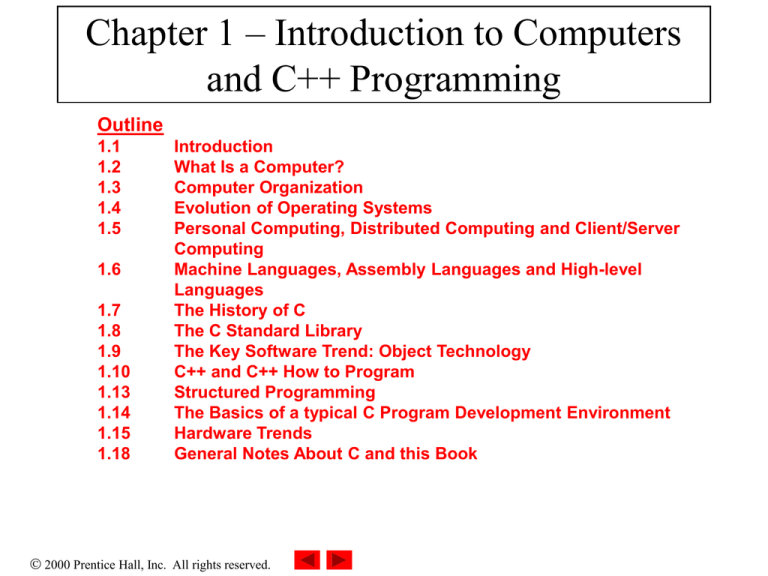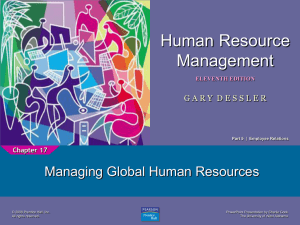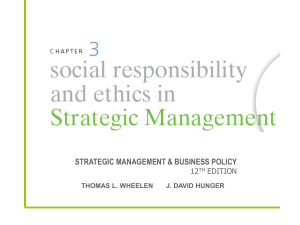
Chapter 1 – Introduction to Computers
and C++ Programming
Outline
1.1
1.2
1.3
1.4
1.5
1.6
1.7
1.8
1.9
1.10
1.13
1.14
1.15
1.18
Introduction
What Is a Computer?
Computer Organization
Evolution of Operating Systems
Personal Computing, Distributed Computing and Client/Server
Computing
Machine Languages, Assembly Languages and High-level
Languages
The History of C
The C Standard Library
The Key Software Trend: Object Technology
C++ and C++ How to Program
Structured Programming
The Basics of a typical C Program Development Environment
Hardware Trends
General Notes About C and this Book
2000 Prentice Hall, Inc. All rights reserved.
1.1 Introduction
–
We will learn the C programming language
–
–
–
Learn structured programming and proper programming
techniques
Chapter 15 - Introduction to C++, a superset of C (more later)
This course is appropriate for
–
–
Technically oriented people with little or no programming
experience
Experienced programmers who want a deep and rigorous
treatment of the language
2000 Prentice Hall, Inc. All rights reserved.
1.2
What is a Computer?
• Computer
– Device capable of performing computations and making logical
decisions
– Computers process data under the control of sets of instructions
called computer programs
• Hardware
– Various devices comprising a computer
– Keyboard, screen, mouse, disks, memory, CD-ROM, and
processing units
• Software
– Programs that run on a computer
2000 Prentice Hall, Inc. All rights reserved.
1.3 Computer Organization
•
Six logical units in every computer:
1.
Input unit
•
2.
Output unit
•
3.
Performs arithmetic calculations and logic decisions
Central processing unit (CPU)
•
6.
Rapid access, low capacity, stores input information
Arithmetic and logic unit (ALU)
•
5.
Outputs information (to screen, to printer, to control other devices)
Memory unit
•
4.
Obtains information from input devices (keyboard, mouse)
Supervises and coordinates the other sections of the computer
Secondary storage unit
•
Cheap, long-term, high-capacity storage, stores inactive programs
2000 Prentice Hall, Inc. All rights reserved.
1.4 Evolution of Operating Systems
• Batch processing
– Do only one job or task at a time
• Operating systems
– Manage transitions between jobs
– Increased throughput - amount of work computers process
• Multiprogramming
– Many jobs or tasks sharing the computer resources
• Timesharing
– Runs a small portion of one user’s job then moves on to service the
next user
2000 Prentice Hall, Inc. All rights reserved.
1.5 Personal Computing, Distributed
Computing, and Client/Server Computing
• Personal computers
– Economical enough for individual
• Distributed computing
– Computing distributed over networks
• Client/server computing
– Sharing of information across computer networks
between file servers and clients (personal computers)
2000 Prentice Hall, Inc. All rights reserved.
1.6 Machine Languages, Assembly
Languages, and High-level Languages
•
Three types of programming languages
1. Machine languages
–
–
Strings of numbers giving machine specific instructions
Example:
+1300042774
+1400593419
+1200274027
2. Assembly languages
–
–
English-like abbreviations representing elementary computer
operations (translated via assemblers)
Example:
LOAD
BASEPAY
ADD
OVERPAY
STORE GROSSPAY
2000 Prentice Hall, Inc. All rights reserved.
1.6 Machine Languages, Assembly
Languages, and High-level Languages (II)
3. High-level languages
–
–
Similar to everyday English and use mathematical notations
(translated via compilers)
Example:
grossPay = basePay + overTimePay
2000 Prentice Hall, Inc. All rights reserved.
1.7 History of C
• C
– Evolved by Ritchie from two previous programming languages,
BCPL and B
– Used to develop UNIX
– Now, most operating systems written with C or C++
– Hardware independent (portable)
– By late 1970's C had evolved to "Traditional C"
• Standardization
– Many slight variations of C existed, and were in compatible
– Committee formed to create a "unambiguous, machineindependent" definition
– Standard created in 1989, updated in 1999
2000 Prentice Hall, Inc. All rights reserved.
1.8 The C Standard Library
• C programs consist of pieces/modules called
functions
– A programmer can create his own functions
• Advantage: the programmer knows exactly how it works
• Disadvantage: time consuming
– Programmers will often use the C library functions
• Use these as building blocks
– Avoid re-inventing the wheel
• If a premade function exists, generally best to use it rather than
write your own
• Library functions carefully written, efficient, and portable
2000 Prentice Hall, Inc. All rights reserved.
1.9 The Key Software Trend: Object
Technology
• Objects
– Reusable software components that model items in the
real world
– Meaningful software units
• Date objects, time objects, paycheck objects, invoice objects,
audio objects, video objects, file objects, record objects, etc.
• Any noun can be represented as an object
– Very reusable
– More understandable, better organized, and easier to
maintain than procedural programming
– Favor modularity
2000 Prentice Hall, Inc. All rights reserved.
1.10 C++ and C++ How to Program
• C++
– Superset of C developed by Bjarne Stroustrup at Bell Labs
– "Spruces up" C, and provides object-oriented capabilities
• Objects - reuseable software components
– Object-oriented design very powerful
• 10 to 100 fold increase in productivity
– Dominant language in industry and university
• Learning C++
– Because C++ includes C, some feel it is best to master C,
then learn C++
– Starting in Chapter 15, we begin our introduction to C++
2000 Prentice Hall, Inc. All rights reserved.
1.14 Basics of a Typical C Program
Development Environment
• Phases of C++ Programs:
1. Edit
2. Preprocess
3. Compile
4. Link
5. Load
Editor
Preprocessor
Compiler
Linker
Disk
Program is created in
the editor and stored
on disk.
Disk
Preprocessor program
processes the code.
Disk
Compiler creates
object code and stores
it on disk.
Disk
Linker links the object
code with the libraries,
creates a.out and
stores it on disk
Primary
Memory
Loader
Loader puts program
in memory.
Disk
6. Execute
..
..
..
Primary
Memory
CPU
2000 Prentice Hall, Inc. All rights reserved.
..
..
..
CPU takes each
instruction and
executes it, possibly
storing new data
values as the program
executes.





